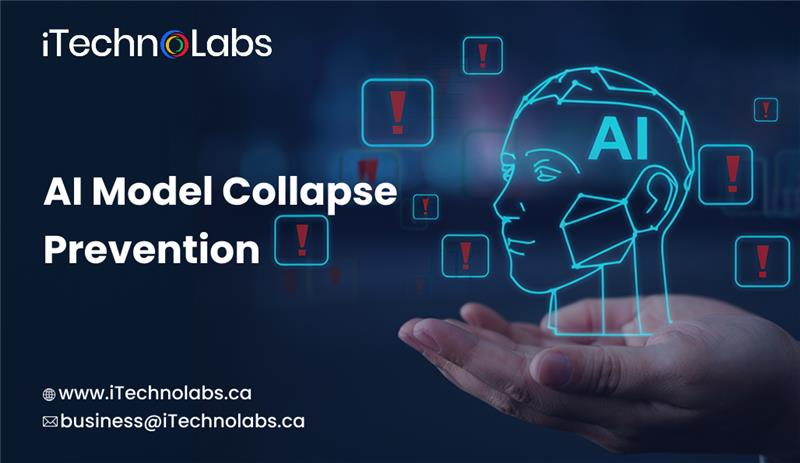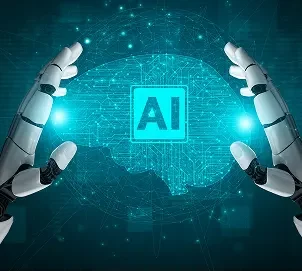Imagine if your most reliable tool starts hallucinating and gives you the same output again and again. Doesn’t sound good right ? Well this is termed as AI model collapse, when AI tools like ChatGPT, Gemini, Perplexity and others produce low-quality, less varied results consistently.
This is a crucial issue since millions of people worldwide rely on AI models for their everyday decisions and choices. When these models start generating degraded content, it negatively affects people’s lives. The AI model collapse not only affects individuals but organizations too that are completely dependent on these advanced softwares. To fully utilize the capacity of these advanced tools, it’s essential to prevent AI model collapse. Read this blog to learn what AI models collapse is, its causes, and solutions. Let’s get started.
Understanding AI Model Collapse Prevention
Model collapse in machine learning refers to a situation when the AI models are not able to provide different useful outputs. Rather it produces low quality and repetitive results. This is a common issue faced while training complex models such as generative adversarial networks (GAN). Model collapse is like machine breakdown that affects the AI models’ ability to produce a wide range of valuable outputs.
Let’s see an example. Imagine there is an AI tool designed to create blogs. Now a person gives it the prompt to write a blog for their website. In the beginning it produces a high-quality article exactly matching the tone of the audience, however as the person gives more and more prompts to refine the content, the quality starts deteriorating. Giving new prompts does not make the content better, but keeps getting worse.
Researchers have started taking interest in using synthetic and real data to train AI models when it comes to generating text. However, one also needs to understand the concept known as “Model Autophagy Disorder”.
This model basically says that if we don’t add fresh and latest data to the AI models, it will lose their capacity to generate high quality text. Therefore, it is important to make a perfect balance between synthetic and real data when training AI tools.
This balance helps to maintain and increase the quality of content AI tools generate. Striking a balance between synthetic and real data is the ongoing challenge worldwide.
Here is another example to understand this model: Consider ChatGPT as the compact version of the internet just like JPG is the compressed version of a photograph. The training of ChatGPT is the same as making photocopies of the photocopies. Simply put, the more copies you make, the worse the picture quality will be.
To overcome this challenge, organizations need to change their approach so that the generative AI tools produce better quality responses.
What Causes AI Model Collapse?
AI model collapse happens when training data, system design, or feedback loops create distortions that weaken performance over time. Models may lose accuracy, amplify noise, or overlook rare but critical cases if data diversity is poor or bias is unchecked. Over-reliance on repetitive outputs further accelerates degradation, limiting adaptability. By understanding these causes, researchers and developers can design safeguards that reduce risks and preserve model reliability across real-world applications, making prevention a central part of AI development.
1. Loss of Rare Events
AI models rely on diverse datasets to make accurate predictions. When training data becomes saturated with repetitive or synthetic information, rare events gradually disappear from the learning pool. These uncommon but crucial signals, such as anomalies or edge cases, are essential for balanced decision-making. Their absence causes models to generalize poorly, ignore outliers, and fail in real-world applications. Over time, this erodes model robustness, leading to collapse when unexpected scenarios occur outside typical training patterns.
2. Amplification of Biases
Bias naturally exists in human-created data, but AI models trained repeatedly on such skewed inputs tend to amplify it. Each iteration reinforces dominant patterns while suppressing minority representations. This creates feedback loops where errors become magnified instead of corrected. For example, biased hiring or medical datasets can worsen inequality if unchecked. As models increasingly depend on their own outputs, biases compound further, eventually distorting predictions beyond usability. This unchecked amplification accelerates the path to AI model collapse.
3. Narrowing of Generative Capabilities
When AI models only learn from their generated data it often loses generative capabilities. The AI tools then start producing similar kinds of content with least diversity and no representation of rare events. This often leads to lack of originality. For example, while using large language models (LLM), every artist or writer has their own distinct tone and voice which AI won’t be able to capture if it’s trained on the same old data.
Research says that if the latest data is not added during the training process, the models will produce less accurate results and the variety will decrease over time.
4. Functional Approximation Error
The functional approximation error occurs when the function approximators used to train AI models are not very expressive. While this error can be minimized by using more and more expressive models it leads to noise and overfitting. Hence to remove this error it’s important to make the right balance between expressiveness and noise control.
Suggested Article: Role of AI in Business Intelligence
Why Does AI Model Stability Matters ?
AI model stability ensures that systems consistently deliver accurate, fair, and safe outcomes across different contexts. Without stability, models may produce unreliable predictions, erode user trust, and even cause economic or social harm. Businesses depend on stable AI for long-term efficiency, while researchers rely on it for innovation. From healthcare diagnostics to financial analysis, stability determines practical value. Recognizing its importance helps organizations invest in strategies that make AI more resilient, accountable, and effective in serving human needs.
1. Reliability and Quality
When the AI models can’t learn anything new the content it produces loses its reliability and the quality also goes down. This usually happens when the AI tools don’t get new and fresh data for training and start relying on their own interpretations of reality. For example an AI model designed to generate news may produce false and inaccurate news articles.
2. Representation and Fairness
Fairness and representation of content is another issue that comes into picture due to AI model collapse. When a model forgets rare events it may not be able to represent the content related to less popular topics in its true form. This leads to stereotypes and biases.
3. Ethical Dilemma
Model collapse raises the question of ethical consideration. When an AI model generates false and inaccurate results it can negatively affect people’s lives and choices.
AI models have the power to influence people’s decisions and when these advanced tools produce wrong results, it can damage people’s lives.
4. Social and Economical Impact
The AI model collapse also affects on a social and economical level. If these tools produce unreliable results people may resist adopting AI technologies. When the AI generated content is inaccurate and of less variety, consumers and businesses may hesitate to use these softwares. When trust is broken people will not use this advanced software to make their lives easier.
5. AI Hallucination
Another common problem due to AI model collapse is AI hallucination. AI hallucination means when the AI tools create content which is not at all related to the real facts and is just imaginative. This usually results in false information which creates confusion among people. This problem is crucial for highly sensitive information like news, healthcare, and legal where accuracy and reliability are of utmost priority.
Check the following example of AI hallucination
Let’s suppose that there is an AI tool that is trained to generate pictures of animals. Now a person requests it to generate a picture of an animal. Then the model produces a gifant, which is a hybrid between a giraffe and elephant. While this image may look visually stunning, it’s important to understand that it’s just an imaginary animal as no such animal exists in the real world.
AI Model Collapse Solutions
AI model collapse can undermine reliability and trust, making proactive solutions essential. Addressing this challenge requires strategies that preserve diversity in training data, reduce bias, and encourage model transparency. Techniques such as reinforcement learning with human feedback, continuous data updates, and robust validation frameworks help maintain accuracy over time. Additionally, collaboration between researchers, developers, and regulators is vital to set ethical standards and prevent harmful outcomes. Together, these solutions ensure AI systems remain stable, adaptable, and beneficial.
-
Diverse Training Data
For AI model collapse prevention, it’s crucial to create a data set which includes a diverse range of data to train AI models. This data should include both the real-world data which accurately defines the complexities of the problem and AI-generated synthetic data. It is important to feed the latest data into the AI models regularly to ensure the content output is always fresh.
-
Consistently Refresh Synthetic Data
Another AI model collapse prevention method is to regularly update the synthetic data for AI models. When new, authentic and reliable data is introduced in the training pipeline, AI models can generate accurate results. In this way the AI models can be prevented from getting stuck in the repetitive loop. Ultimately, AI models will generate relevant and fresh outputs.
-
Regular Evaluation
The next method for AI model collapse prevention is to regularly evaluate the quality of content AI tools are generating. This helps to early detection of any potential collapse. Organizations can implement MLOps (machine learning operations) for consistent monitoring and alignment with the organizational goals.
-
Fine-Tuning
To maintain model stability and prevent AI model collapse, one can consider using fine-tuning strategies. This strategy enables the model to adapt while also securing previous knowledge. This AI model collapse prevention strategy can prevent any breakdowns in the technology.
-
Bias and Fairness Analysis
One of the most effective AI model collapse prevention methods is rigorous bias and fairness analysis. By addressing the biases in the model’s output, one can take preventive measures and stop the model collapse. By regularly monitoring these biases, people can ensure the model’s reliability.
-
Feedback Loops
Last but not the least method to prevent AI model collapse is implementing feedback loops. By regularly collecting user insights, necessary adjustments can be made to the outputs of models. This process ensures that the model’s output remains relevant, reliable, accurate, and fulfills the needs of the users.
Also, read: AI in Architecture
Conclusion
In 2025 when the whole world is using AI to make better decisions and make their life easier, the AI model collapse is a critical issue that needs to be resolved as soon as possible.
The AI model collapse leads to inaccurate and unreliable results that can negatively impact the people’s lives and their choices. When these advanced models collapse, it starts generating imaginary results which do not align with real facts and figures. The AI model collapse occurs mainly due to increase in biases, lack of rare events, and functional approximation error.
For organizations that want to use the advanced capitalities of these software, the AI collapse is nothing short of a nightmare. However you don’t need to worry, as you can partner with iTechnolabs that can create AI agents customized to your specific needs and requirements. iTechnolabs is a 9 year old company with 230+ team members and more than 840 projects delivered successfully. Visit the website now and boost your business with AI tools.
FAQs
1. What is model collapse in AI?
The AI model collapse refers to a situation when the AI tools start producing repetitive, inaccurate and less-varied results because it was trained on the outputs of other models. This is known as synthetic data. The collapse of AI models leads to unreliable results which can also create confusion among users.
2. Why will AI collapse?
AI model collapse mainly occurs when it is trained on the outputs of other models rather than real-world data. This leads to generation of inaccurate results and AI hallucination. In this process the output generated by AI models starts degrading as it is continuously trained on synthetic output.
3. How to prevent AI model collapse?
There are various methods to prevent AI models from collapsing such as using a wide range of data to train, regularly refreshing synthetic data, consistent evaluation, fine tuning, analyzing biases and implementing feedback loops.









